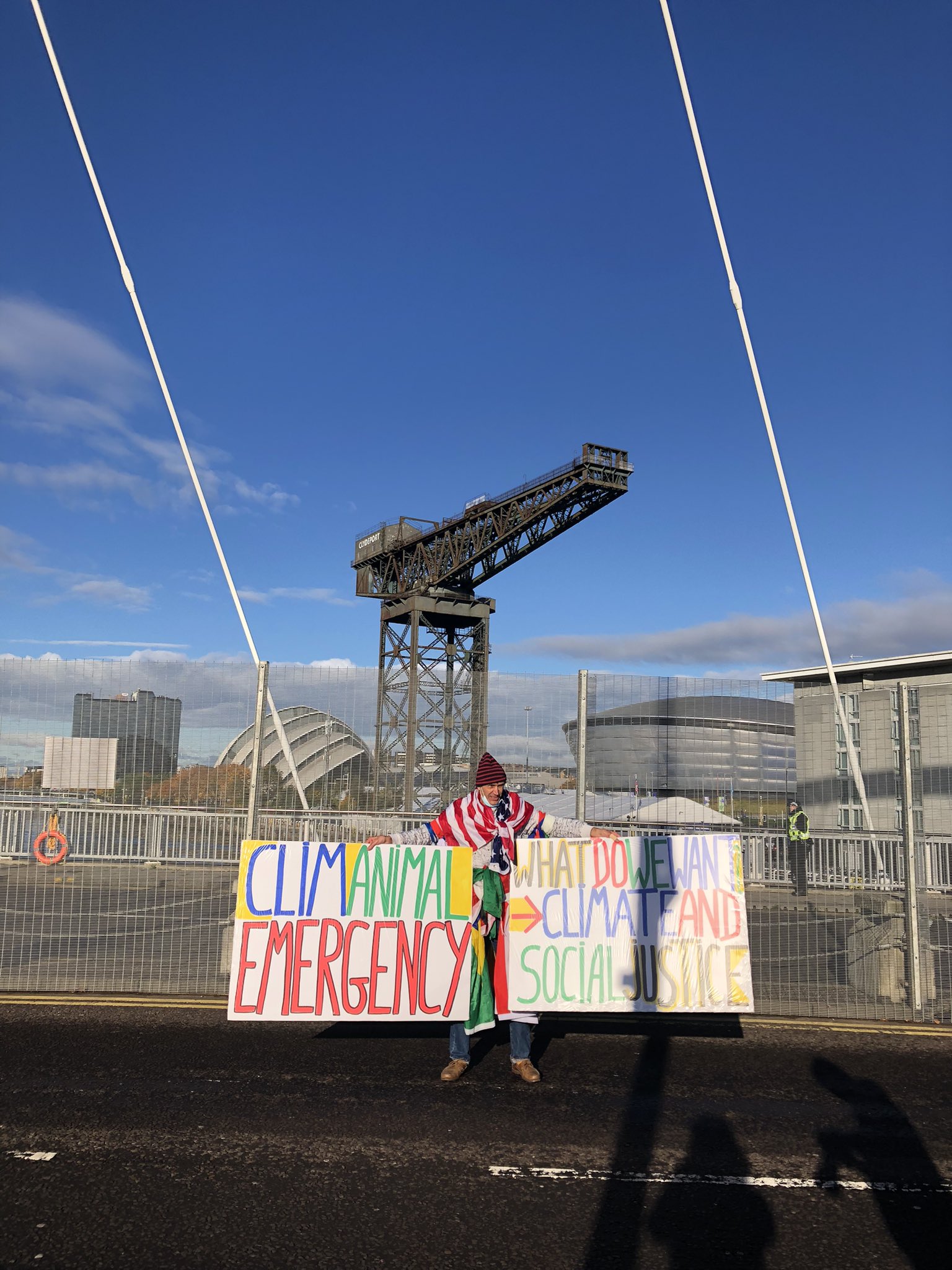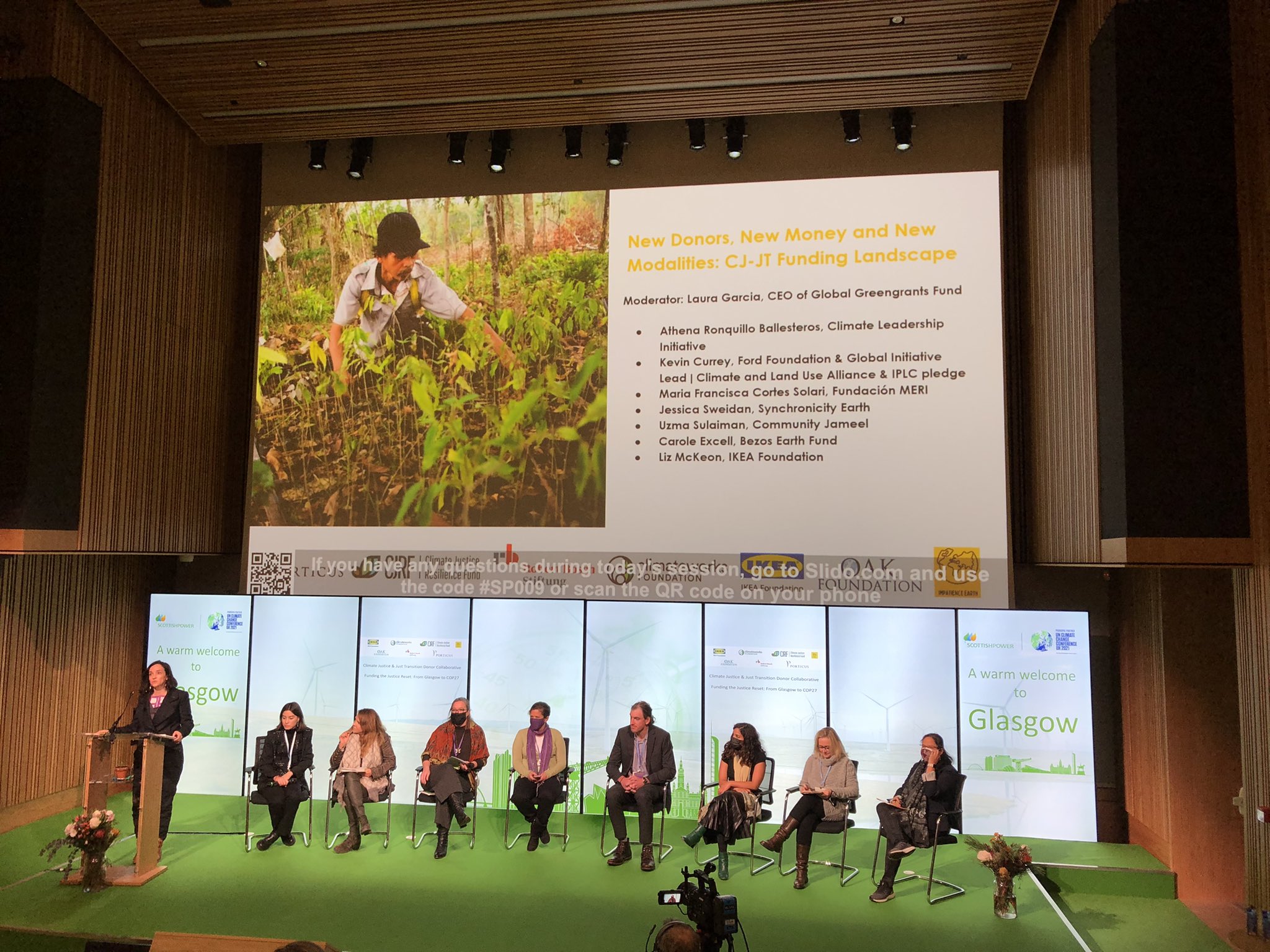In November, all eyes were on Glasgow. World leaders came together to negotiate how best to limit global warming to 1.5°C, or at least well below 2°C, and deliver the climate action we urgently need to ensure a livable future. Outside the official ‘Blue Zone’, which is where these negotiations took place, civil society, social movements, philanthropy representatives, business leaders, artists and others joined the conversation, shared their perspectives, showcased solutions and tried to hold the decision-makers accountable.
In this interview, Elika Roohi, Digital Editor of Alliance Magazine, Eva Rehse, Executive Director of Global Greengrants Fund UK and co-chair of the board of EDGE Funders Alliance, and Florence Miller, Director of the Environmental Funders Network, share their personal take on COP26 highlighting its relevance for the PEXcommunity and what philanthropy should prioritise in the coming year.
What made you feel excited about COP26? What were your frustrations?
 Florence Miller, Environmental Funders Network: COPs are incredible as organising moments for civil society: a reason and an opportunity for people from across the world to come together, both online and in person. Seeing the breadth, depth, energy, commitment and passion of civil society leaders and activists from around the world in Glasgow was hugely inspiring. Outside the formal negotiations there were almost endless opportunities to hear perspectives on climate change from all over the world — though the opportunities for those perspectives to be represented in the negotiating rooms were significantly less extensive. The energy pulsating from the people who showed up was palpable: it felt like being at the crest of a wave. And though there were huge frustrations about power imbalances in the negotiations, it felt as though something shifted this year in terms of the power of the people to influence the process. Maybe that’s just me: I’d only ever been to one other COP, so who am I to judge…!
Florence Miller, Environmental Funders Network: COPs are incredible as organising moments for civil society: a reason and an opportunity for people from across the world to come together, both online and in person. Seeing the breadth, depth, energy, commitment and passion of civil society leaders and activists from around the world in Glasgow was hugely inspiring. Outside the formal negotiations there were almost endless opportunities to hear perspectives on climate change from all over the world — though the opportunities for those perspectives to be represented in the negotiating rooms were significantly less extensive. The energy pulsating from the people who showed up was palpable: it felt like being at the crest of a wave. And though there were huge frustrations about power imbalances in the negotiations, it felt as though something shifted this year in terms of the power of the people to influence the process. Maybe that’s just me: I’d only ever been to one other COP, so who am I to judge…!
From the negotiations standpoint, COP26 certainly wasn’t the disaster it could have been. In total, the commitments did not bring us close to where we need to be in terms of limiting temperature rises, but the conference resulted in a process that will keep that possibility alive: notably the commitment to states returning in a year (rather than five years) with ratcheted-up commitments. Likewise, thanks to the efforts of the countries most vulnerable to climate change, there was much clearer support for trying to limit temperature rises to 1.5°C, as opposed to the less than 2°C committed to in the Paris Agreement.
 Eva Rehse, Global Greengrants Fund UK & EDGE Funders: I think everybody went into this COP with low expectations, and it was at times heart-breaking to witness the sheer inability of our political representatives to put aside national short-term interests for our common good. This COP was meant to “keep 1.5 alive”– that happened, but barely. Even at first promising commitments on coal exit and halting of deforestation ended up feeling stale once analysed thoroughly.
Eva Rehse, Global Greengrants Fund UK & EDGE Funders: I think everybody went into this COP with low expectations, and it was at times heart-breaking to witness the sheer inability of our political representatives to put aside national short-term interests for our common good. This COP was meant to “keep 1.5 alive”– that happened, but barely. Even at first promising commitments on coal exit and halting of deforestation ended up feeling stale once analysed thoroughly.
But I am excited by the civil society mobilisation we saw – from the wonderful host community in Glasgow and work of the COP26 Coalition to Indigenous representatives and grassroots activists from the global South who managed to attend despite many challenges. Their presence and voices helped hold the negotiators to account, and grounded us all in the realities of the climate crisis.
 Elika Roohi, Alliance Magazine: Walking through Glasgow during COP26, queuing alongside hundreds of delegates every day to get into the venue, and marching along with the thousands of youth climate activists speaking out for their future – I came away from Glasgow with a budding sense of hope. Yes, the challenge ahead of us demands so much from humanity, and yes, by all measures we are falling short – but I found it encouraging to be in the company of so many people who had come together to solve this crisis that will touch us all.
Elika Roohi, Alliance Magazine: Walking through Glasgow during COP26, queuing alongside hundreds of delegates every day to get into the venue, and marching along with the thousands of youth climate activists speaking out for their future – I came away from Glasgow with a budding sense of hope. Yes, the challenge ahead of us demands so much from humanity, and yes, by all measures we are falling short – but I found it encouraging to be in the company of so many people who had come together to solve this crisis that will touch us all.
Philanthropy-wise, I was encouraged to see the sector learn from its actions at previous COPs and scale the action up, i.e. taking the model of providing funding to the Kigali Amendment in 2016 and applying it on a much larger scale with the Global Methane Pledge this year. The $1.7bn from several major foundations and Western nations also felt like a turning point in recognising both the role of protecting forest and how important it is for Indigenous peoples to be involved in that work, and I hope it reflects a turning point in who gets the funds and what climate work we are prioritising.
It was frustrating that COP26 closed without any firm commitment from nation states to fund loss and damage – what island nations and other communities living on the frontlines of climate change have been asking for as they experience floods, cyclones, hurricanes, fires, and other extreme weather events. A group of foundations made a small start, pledging $3m in an attempt to nudge governments in that direction. But their prompt went unanswered. At one of the sessions I attended, Climate Action Network International’s Tasneem Essop, said: ‘Finance for loss and damage is the litmus test of the outcome of Glasgow. This is an issue we can no longer ignore.’
The summit closed without it – what does that say?
What are your learnings?
Elika: Over the time I was in Glasgow, I was both inside and outside “the tent”. The conversations we were having inside venues with door checks and invitations with the philanthropy community tried to tease out how new funders on the scene were making an impact or what were the priority areas in why. But when we joined the youth activists, marching outside on Friday, none of them felt like anyone was moving fast enough. Jeff Bezos had a high profile at COP, committing $2bn to climate causes – the largest sum of any donor at COP. But that didn’t matter on the streets, people asked: how much could he really be invested in solving the climate crisis if he flew in on a private jet? There’s a big disconnect between what philanthropy is doing and what the average person feels like donors with money should be doing, and I think learning to bridge that gap through more involvement with social movements could go a long way.

A climate protestor outside the Blue Zone.
Eva: This COP has reiterated that our future lies with grassroots movements; ordinary people who went out on the street to call for climate justice; Indigenous Peoples who have been sharing their climate solutions with us; and young people who once again were the most vocal and clear-headed people in the COP. Only thanks to civil society observers do we understand what really happened on the inside vs the rhetoric that we were sold on the outside.
Florence: That it’s vital to keep in mind what success looks like. Within the framework of the COP processes, Glasgow was surprisingly successful. Progress was made. But people outside the gates were still furious — because success in a multilateral process does not necessarily immediately translate into success in terms of staving off disaster for millions — billions — of people around the globe. We need these multilateral negotiations, and they are inevitably going to be complicated and bogged down by individual states’ (and international) politics, but a key role for civil society is to constantly remind those involved of what is at stake, and that we no longer have time for incremental change. To keep the fire under the process.
What’s relevant for the PEXcommunity?
Eva: There was a smaller than usual presence of foundation representatives, but thanks to the efforts of funder networks we were able to find each other, and there were some good exchanges and networking opportunities. One notable occasion was the Justice Reset event organised by the Climate Justice – Just Transition Donor Collaborative which brought together foundation representatives with practitioners and activists during COP. The framing of climate justice and just transition will become more and more prominent in climate philanthropy, and we need to ensure that our strategies are rooted in the analysis of movements that have been working on these concepts for a very long time.

A panel on climate justice at the Scottish Power Headquarters.
Elika: One of the simplest things members of the PEXcommunity can do is look for the climate commitments that cover their region and encourage their members to become signatories. There are national commitments in many European countries, one in Canada, one in the US for donors who want to apply a climate and racial justice lens to their grantmaking, and the international commitment organised by WINGS. Signing on to a climate commitment connects foundations with a network of organisations trying to also improve their own climate programming and actions and philanthropy infrastructure has a crucial role in driving and supporting this.
What should the priority for action be for philanthropy?
Florence: The most significant new call to action at COP26 for funders was the Climate Justice and Just Transition Donor Collaborative’s call for philanthropy to provide $1 billion in funding for loss and damage in the next year. Loss and damage was one of the most contentious aspects of COP26: those countries the are losing the most because of climate change — lives, land, economies — have almost inevitably contributed the least to it, and they need to be compensated. Mia Mottley, Prime Minister of Barbados, put it like this: ‘It’s like throwing rubbish into someone’s front yard and telling them they have to pay to clean it up, but the clean-up costs so much that they can’t pay their mortgage or any of their other expenses.’ At a time when philanthropy is still giving not nearly enough on climate mitigation (amounting to just 2% of overall European giving by this latest count), this call to action may feel overwhelming but it’s hugely important. How can philanthropic funds be used to unlock state spending on loss and damage, just as they have been used to do the same for mitigation and adaptation.

Fridays for Future march in Glasgow on 5 November
Elika: Between this COP and the next, I’d like to see philanthropy use its influence on the following:
- Continue pushing governments on the issue of funding loss and damage. $3m was a modest start, but there’s so much further to go, and the matter will only become more serious as we get further into this decade.
- Think about how philanthropy can use ‘soft power’ to bring underrepresented voices to the table at COP. This particular COP was maligned for its lack of access, starting from the most basic way access was designed (who was allowed in, thanks to vaccine mandates which automatically meant much of the world outside of the west couldn’t come) to the logistics on the ground (long queues every day, a lack of disability access). Conversations about climate action absolutely can’t just be happening between leaders of wealthy nations. At this COP, philanthropy did have a voice on the main stage – how can it use that access to bring others with it?
- Break the 2% barrier! Less than 2% of all philanthropic funding goes to climate, and this figure hasn’t budged for years. It’s time for philanthropy to step up and start allocating the kinds of real resources that will meet the crisis ahead.
Eva: I would highlight two things: One of the concrete outcomes on the sidelines of COP was the commitment from philanthropies, including my own foundation, to help kickstart the Glasgow Loss and Damage Facility. While progress on climate finance was one of the major failings of the COP, this is where philanthropy can help meet immediate needs, and call for more ambitious government interventions.
The second priority is now to continue to support civil society to hold governments to account to fulfil their promises and pledges. Grassroots movements are leading the charge in mobilising communities, implementing climate solutions, and calling for greater ambition and visionary leadership. As we look ahead to COP27, we need to support this momentum – with every year and every COP that passes, our windows of opportunity are closing, but we have not run out of time yet.
This article was first published by PEXnews on 26 November 2021. Sign up for the PEX newsletter here.






Comments (0)